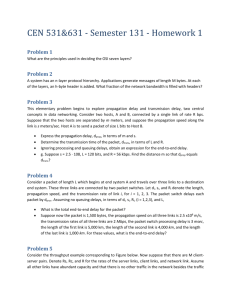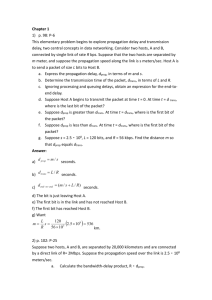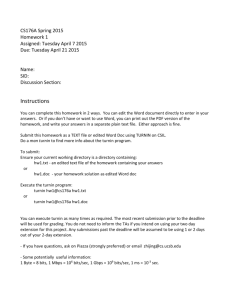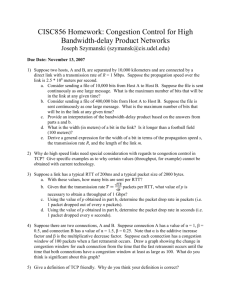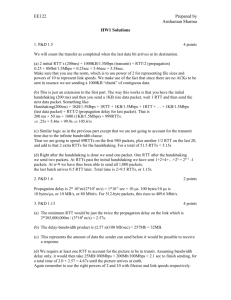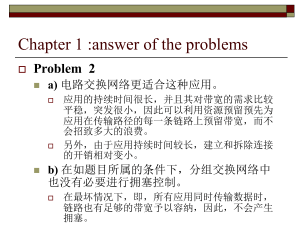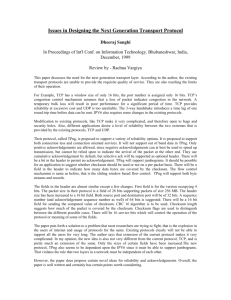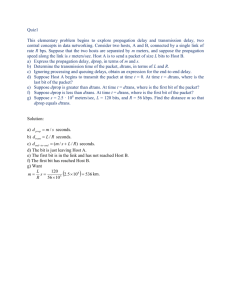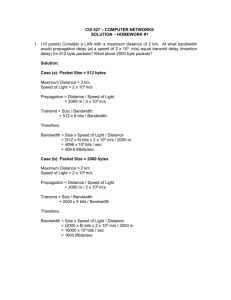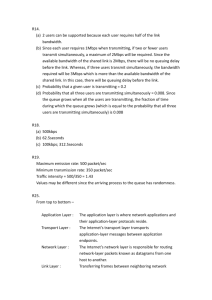P. 1
advertisement
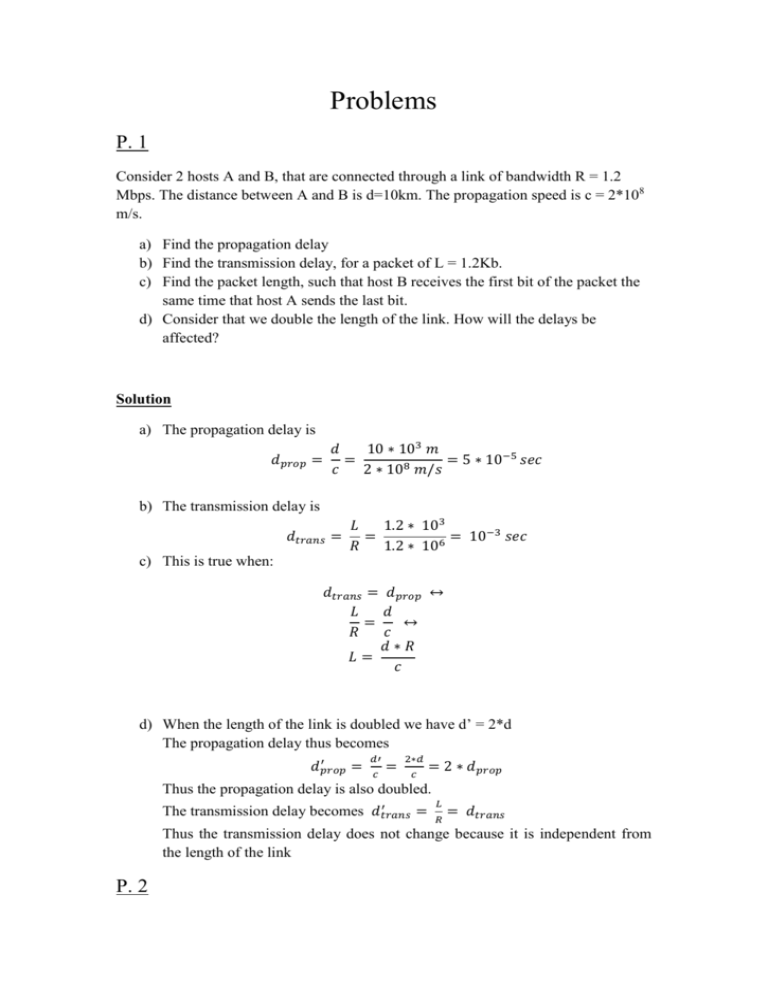
Problems P. 1 Consider 2 hosts A and B, that are connected through a link of bandwidth R = 1.2 Mbps. The distance between A and B is d=10km. The propagation speed is c = 2*108 m/s. a) Find the propagation delay b) Find the transmission delay, for a packet of L = 1.2Kb. c) Find the packet length, such that host B receives the first bit of the packet the same time that host A sends the last bit. d) Consider that we double the length of the link. How will the delays be affected? Solution a) The propagation delay is 𝑑𝑝𝑟𝑜𝑝 𝑑 10 ∗ 103 𝑚 = = = 5 ∗ 10−5 𝑠𝑒𝑐 𝑐 2 ∗ 108 𝑚/𝑠 b) The transmission delay is 𝑑𝑡𝑟𝑎𝑛𝑠 = 𝐿 1.2 ∗ 103 = = 10−3 𝑠𝑒𝑐 𝑅 1.2 ∗ 106 c) This is true when: 𝑑𝑡𝑟𝑎𝑛𝑠 = 𝑑𝑝𝑟𝑜𝑝 ↔ 𝐿 𝑑 = ↔ 𝑅 𝑐 𝑑∗𝑅 𝐿= 𝑐 d) When the length of the link is doubled we have d’ = 2*d The propagation delay thus becomes ′ 𝑑𝑝𝑟𝑜𝑝 = 𝑑′ 𝑐 = 2∗𝑑 𝑐 = 2 ∗ 𝑑𝑝𝑟𝑜𝑝 Thus the propagation delay is also doubled. ′ The transmission delay becomes 𝑑𝑡𝑟𝑎𝑛𝑠 = 𝐿 𝑅 = 𝑑𝑡𝑟𝑎𝑛𝑠 Thus the transmission delay does not change because it is independent from the length of the link P. 2 Find the time required for the transmission of a file of M bits in a network that uses TDMA with N time-slots. The total bandwidth is B bits/sec. Also consider that the end-to-end circuit establishment needs time τ sec. Ignore the length of the packet header. Solution Consider that the length of a single time-slot is t seconds. So, in a single-time slot B*t 𝑀 bits are transmitted. Given that the total length of the file is M bits, r = 𝐵∗𝑡 total TDMA rounds are needed for whole file to be transmitted. Every TDMA round lasts for N*t seconds. So, for the transmission of the file 𝛿 = 𝑁∗𝑡∗𝑟 =𝑁∗𝑡∗ 𝑀 𝐵∗𝑡 = 𝑁∗𝑀 𝐵 seconds are needed. In this time we must also add the time that the end-to-end circuit needs in order to be established, so the total time needed is 𝜏+𝛿 =𝜏+ 𝑁∗𝑀 𝑠𝑒𝑐 𝐵 P. 3 Consider sending a large file of F bits from Host A to Host B. There are two links (and one switch) between A and B, and the links are uncongested (i.e., no queueing delays). Host A segments the file into segments of S bits each and adds 40 bits of header to each segment, forming packets of L = 40 + S bits. Each link has a transmission rate of R bps. Find the value of S that minimizes the delay of moving the packet from Host A to Host B. Neglect propagation delay. Answer The total number of packets are F/S. Assume that F/S is integer. Denote, h = 40, the header size. The total delay will be ( (𝑆 + ℎ)𝐹 𝑆 + ℎ 𝑆+ℎ 𝐹 1 𝐹ℎ ) ( + 1) = + = (𝐹 + 𝑆 + ℎ + ) 𝑅 𝑆 𝑅𝑆 𝑅 𝑅 𝑆 Taking the derivative of the delay for S 1 ℎ𝐹 (1 − 2 ) 𝑅 𝑆 And setting it to zero we have 1 ℎ𝐹 (1 − 2 ) = 0 ↔ 𝑅 𝑆 ℎ𝐹 (1 − 2 ) = 0 , 𝑠𝑖𝑛𝑐𝑒 𝑅 𝑐𝑎𝑛𝑛𝑜𝑡 𝑏𝑒 0 𝑆 𝑆 2 = ℎ𝐹 ↔ 𝑆 = √ℎ𝐹 So the value of S that minimizes the delay of moving the packet from Host A to Host B is √ℎ𝐹 P. 4 Suppose users share a 1 Mbps link. Also suppose each user requires 100 Kbps when transmitting, but each user only transmits 10% of the time. (See the discussion on "Packet Switching versus Circuit Switching" in Section 1.4.1.) a) When circuit-switching is used, how many users can be supported? b) For the remainder of this problem, suppose packet-switching is used. Find the probability that a given user is transmitting. c) Suppose there are 40 users. Find the probability that at any given time, n users are transmitting simultaneously. d) Find the probability that there are 10 or more users transmitting simultaneously. Answer a) Each user requires 1/10th of the bandwidth. So, when circuit-switching 10 users can be supported. b) Each user transmits 10% of the time so P(a given user is transmitting) = 10/100 = 0.1 c) Consider p the probability that a user transmits, so (1-p) is the probability that a user does not transmit There are (40 ) possible combinations of n users, given that the total users are 𝑛 40. Remember that : (𝑛𝑘) = 𝑛! 𝑓𝑜𝑟 0 ≤ 𝑘 ≤ 𝑛 𝑘!(𝑛−𝑘)! So the probability is: (40 )𝑝𝑛 (1 − 𝑝)40−𝑛 𝑛 d) The probability that 0 or 1 or 2 or … or 9 users transmit is 9 ∑( 𝑛=0 40 𝑛 ) 𝑝 (1 − 𝑝)40−𝑛 𝑛 So the probability that 10 or more users transmit is 9 1− ∑( 𝑛=0 40 𝑛 ) 𝑝 (1 − 𝑝)40−𝑛 𝑛
